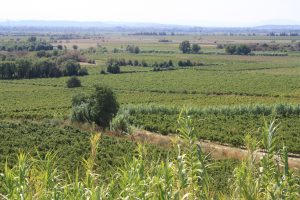If you are going wine tasting in the easternmost part of France, you’ll be in Alsace, where they grow white wine grapes, mostly Riesling and Gewürztraminer. Now, those are German grapes, which is fitting because over the centuries Alsace has gone back and forth from being a part of Germany to being a part of France. It’s been French since the end of the First World War, but was German for 50 years before that.
The principal city of Alsace is Strasbourg. It looks very German in its architecture, but the feeling there is joie de vivre, not gemütlichkeit. Alsace generally and Strasbourg in particular feel like Germany with French people. And the food is a blend of the two as well. There is the expression “to be stuffed like a Strasbourg goose”, perhaps because that’s how you get fois gras, the emperor of all patés. The dish that Alsace is best known for, though, is a mixture of sauerkraut and smoked meats called choucroute.
Photo courtesy of Food and Wine.
Chou is French for cabbage. Put that together with the “kraut” in sauerkraut and you get choucroute. Today you can find this dish on menus all over France, especially in the cooler months and there are places in Paris and Lyon that make it very well. But the best is in Alsace, where it was born, and the best of the best is to be found in Strasbourg. Which restaurant? That’s like asking where’s the best pizza in Brooklyn: Everywhere!
It’s made of sauerkraut that’s baked for hours and towards the end adding the meats. At one time or another, we’ve experienced smoked ham, pork chops, frankfurters, Alsatian sausage, Toulouse sausage, Polish kielbasa, knockwurst, bratwurst, weisswurst, thickly sliced bacon, ham hocks and other meats we weren’t exactly sure about. Some people consider juniper berries to be an essential ingredient but we don’t agree with those people. There are always a few boiled potatoes and lots of Dijon mustard on the side.
On Alsatian menus you’ll also find choucroute fruit de mer, or sauerkraut with seafood, a combination that never really appealed to us. Salmon, haddock, mussels, shrimp, lobster and langoustines replace the smoked meats. It’s something to try once.
Our experiences with choucroute in France all involve overeating. It’s impossible not to. First of all, any respectable restaurant will pile up the sauerkraut on your plate. Figure a pound per person and you’re just getting started. Then all those meats! Each one is so delicious but cumulatively they’re way too much to finish. Of course, the chef could just serve you less, but instead they tempt you with Choucroute Royale, which just means the basic dish, with more of everything. It’s enough for a family of four and you’re supposed to finish it yourself!
Because of its place of origin, most people drink Alsatian wines with choucroute or a beer. Our opinion as wine lovers is that a hearty red wine goes best.






